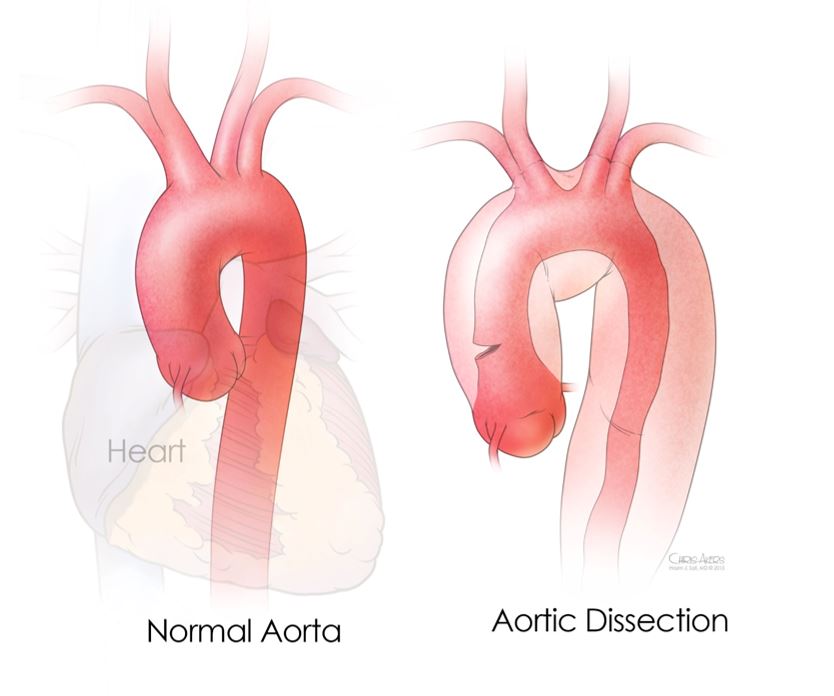What is Aortic Disease?
 What is an aortic aneurysm?
What is an aortic aneurysm?
The aorta is the main vessel that carries blood pumped from the heart to the rest of the body. It is shaped like a candy cane and is typically about as wide as a garden hose (2.5-3.5 cm). An aortic aneurysm is a balloon-like bulge in a portion of the aorta. Aneurysms usually occur where there is a weak spot in the aortic wall. Aortic aneurysms are the 13th leading cause of death in the United States, accounting for an estimated 15,000-20,000 deaths annually.
How are aortic aneurysms classified?
Aortic aneurysms are commonly classified according to their location. Thoracic aortic aneurysms (TAA) involve the ascending aorta, arch, or descending aorta. Abdominal aortic aneurysms (AAA) affect the aorta in the abdominal cavity. A third type of aneurysm, thoracoabdominal, involves both the descending and abdominal aorta.
What are the symptoms of an aneurysm?
Most aneurysms have NO symptoms until they dissect or get extremely large.
 What is an aortic dissection?
What is an aortic dissection?
Aortic dissection: a tear in the inner layer of the aorta that allows blood to flow within the layers of the aorta.
Aortic rupture: a rupture or hole in the aorta that allows blood to burst or leak out into the body.
How are aortic dissections classified?
There are two main systems of classification for aortic dissections, the Stanford Classification and the DeBakey Classification:
Stanford classifies dissections as either:
- Type A (involving the ascending aorta)
- Type B (not involving the ascending aorta)
DeBakey classifies dissections as:
- Type I (affects both the ascending and descending aorta, as well as the aortic arch)
- Type II (affects only ascending aorta)
- Type III (affects only the descending aorta
 What are the symptoms of an aortic dissection?
What are the symptoms of an aortic dissection?
Symptoms of an aortic dissection may include:
- Sudden onset of sharp, severe chest or back pain
- Fainting
- Difficulty breathing
- A sudden change in blood pressure
- Sudden weakness or paralysis on one side
Risk Factors
Several factors increase the risk of developing an aortic aneurysm or dissection, including environmental and genetic influences:
- Uncontrolled hypertension (high blood pressure)
- Smoking
- Bicuspid aortic valve
- Weight lifting (see IRAD for recommendations regarding lifestyle and work)
- Trauma to the aorta (e.g. being in a car accident)
- Inflammatory diseases
- Genetic factors
How is TAA treated?
Early diagnosis can result in early intervention and dramatic improvements. If an aneurysm or dissection is suspected, an ultrasound scan of the heart (echocardiogram) is usually performed. Other scans such as computerized tomography (CT) and magnetic resonance imaging (MRI) may also be performed to determine the exact position and size of an aortic aneurysm. The treatment of an aortic aneurysm depends upon the severity of the aneurysm or dissection and may include medical management (medication) or surgery.
Guidelines for the Diagnosis and Management of Patients With Thoracic Aortic Disease
The Guidelines for the Diagnosis and Management of Patients With Thoracic Aortic Disease in the Journal of the American College of Cardiology (JACC).
The Guidelines document was published in 2010 by the American College of Cardiology Foundation/American Heart Association Task Force on Practice Guidelines, American Association for Thoracic Surgery, American College of Radiology, American Stroke Association, Society of Cardiovascular Anesthesiologists, Society for Cardiovascular Angiography and Interventions, Society of Interventional Radiology, Society of Thoracic Surgeons, and Society for Vascular Medicine.